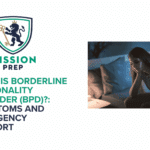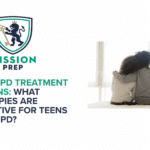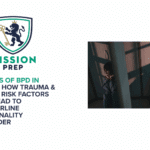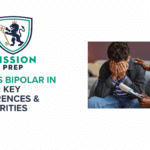BPD Subtypes: The Four Types of Borderline Personality Disorder in Teens

Borderline Personality Disorder (BPD) in adolescents is often misunderstood because the symptoms are difficult to identify. Emotional volatility, identity struggles, and chronic insecurity may all point toward BPD, yet they don’t show up the same way in each teen.
That’s where understanding the four BPD subtypes becomes important. Identifying BPD subtypes in teens helps clinicians and caregivers make sense of the behaviors that might otherwise seem chaotic and unexplained – like emotional withdrawal in one teen and self-destructive behaviors in another.
What’s more, recognizing a teen’s emotional subtype allows for more accurate diagnosis, tailored support, more effective care and, as a result, better long-term outcomes.
This guide explores:
- What borderline personality disorder is
- A breakdown of the four BPD subtypes
- Treatment options for each subtype
- How Mission Prep can help with understanding teen BPD types and treatments
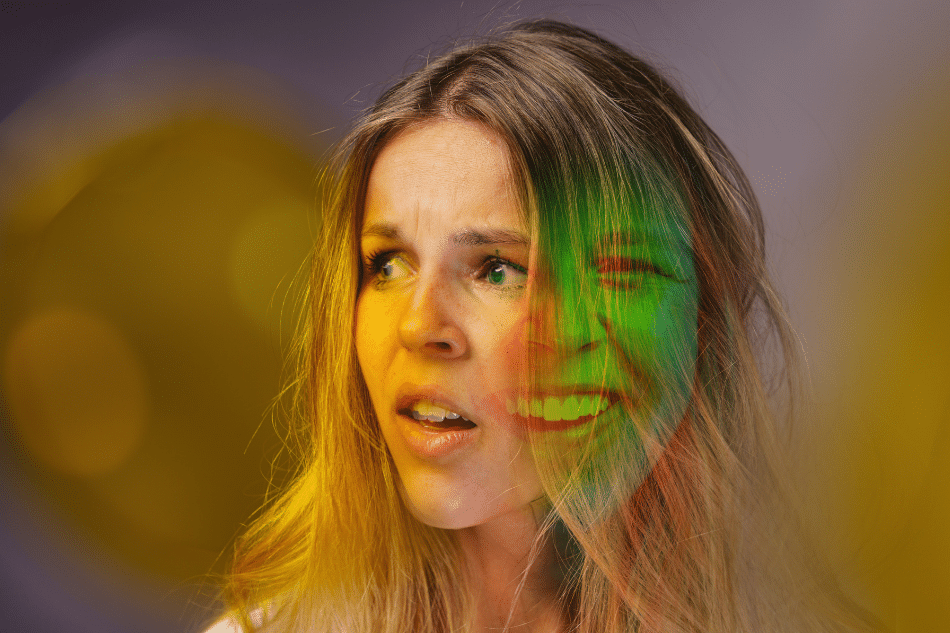
What Is Borderline Personality Disorder?
These behaviors reflect how the brain and nervous system may handle stress, threat, and emotional connection differently for those with BPD.² People with BPD often have an overactive amygdala, which leads to a heightened sensitivity to factors in the environment that trigger intense emotions. As a result, they feel threatened and in danger a lot of the time. In addition, their prefrontal cortex, an area of the brain which helps you calm down and think clearly, may be less responsive.⁴
In teens, whose brains are still developing, these brain differences can be even more pronounced.³ Due to this, emotions may hit them fast and hard, before the brain has time to process and regulate them, potentially leading to unhealthy reactions and distorted self-perceptions over time.
Before we get onto the four types of BPD, it’s important to note that BPD doesn’t have a single cause. While researchers believe that early attachment wounds, chronic invalidation, and trauma are common contributors – especially in sensitive or highly reactive kids – factors like genetics, temperament, and social environment also shape how BPD symptoms develop.⁵,⁶
What Are the Four Types of Borderline Personality Disorder?
Psychologists have identified four types of borderline personality, also known as BPD subtypes in teens. Each one comes with a different emotional presentation, set of behaviors, and coping style, even though they share the same underlying condition.
These four emotional subtypes are:⁷
- The Discouraged Type
- The Impulsive Type
- The Petulant Type
- The Self-Destructive Type
Some teens may show signs from more than one category, but usually, one pattern is dominant. Let’s explore each type, and the recommended treatment for them, in more detail.
BPD Discouraged Type
BPD Discouraged Type – often called “Quiet BPD” – can be mistaken for depression or social anxiety.⁸ These teens may appear calm, shy, or eager to please, but internally they’re struggling with intense emotional pain, shame, and fear of abandonment.
Common signs of BPD discouraged type teens include:
- Constant fear of rejection or disappointment
- Difficulty asserting needs or opinions
- Idealizing people quickly, then crashing emotionally if let down
- Suppressing anger until it leaks out through withdrawal, shutdown, or passive resistance
- A sense of identity that shifts based on who they’re around
This subtype can be hard to recognize because many teens seem to cope well on the surface. They might get good grades, avoid arguments, and seem mature. However, inside, they’re often overwhelmed and struggling with their behaviors, well-being, and relationships.
When left untreated, discouraged-type BPD can lead to long-term patterns of burnout, resentment, or sudden emotional collapse. Untreated discouraged BPD can also carry a risk of suicidal thoughts and self-harm, so treatment is vital to support these teens.
Treatment for Discouraged BPD
For BPD discouraged type teens, the main aims of treatment are to build a sense of identity, assertiveness, and reduce the risk of suicidality. For this reason, psychotherapy is often the first port of call.
Treatments like DBT with a strong mindfulness component, or even psychodynamic therapy that explores early attachment wounds, can help. Group therapy may be useful once trust is built, but only in safe, non-competitive environments.
The Impulsive Type
Impulsive BPD is often misunderstood as recklessness. These teens are often seen as thrill-seeking, unthinking, or disruptive, but their behavior is often a response to overwhelming emotional distress.⁹
Teens with the BPD impulsive type may:
- Act quickly without thinking, through risky sex, drug use, reckless driving, or sudden friendships
- Struggle to sit still or stay present without stimulation
- Experience short bursts of intense anger or sadness followed by guilt
- Chase novelty as a way to avoid emotional discomfort
- Display sudden shifts in energy, goals, or appearance
This isn’t “acting out” – it’s their nervous system in overdrive. The amygdala, which is the part of the brain that detects threats, may be hyperactive. Meanwhile, the prefrontal cortex struggles to regulate impulses. As a result, split-second decisions are often made to relieve pain and get quick rewards, even when the consequences are long-lasting.
Treatment for Impulsive BPD
Teens with the BPD impulsive type benefit most from structured, skills-based therapy like Dialectical Behavior Therapy (DBT). This approach teaches them how to pause before reacting, regulate emotional surges, and tolerate distress without acting out. Treatments often include role-playing, mindfulness for emotional control, and group work that provides safe ways to feel seen without needing constant stimulation or drama.
The Petulant Type
Sometimes, Petulant BPD is overlooked, but with time, the symptoms become more evident. With this type, teens may reach for closeness in one moment, only to seem irritated or completely shut down in the next. However, the anger often masks vulnerability, as these teens are sensitive to feeling let down or rejected, even by seemingly “small” things.
Often, their reactions might seem out of proportion to what actually happened. But to them, these are rational responses to painful situations.
Common signs of teen affective BPD in this subtype include:
- Sudden outbursts followed by guilt or self-loathing¹⁰
- Passive-aggressive communication or stonewalling
- Intense frustration when things feel out of control
- Fear that others will abandon them, even over small mistakes
- Feeling chronically misunderstood, unseen, or dismissed
This pattern reflects their emotional dysregulation, and it’s not a choice. The emotional subtype behaviors seen in petulant teens are driven by a hypersensitive threat system and a reward system that struggles to establish safety, security, and connection.
Treatment for Petulant BPD
Dialectical Behavior Therapy (DBT) is especially effective here as it teaches skills for managing anger, improving interpersonal communication, and tolerating distress without lashing out or withdrawing. Family therapy can also play a key role, helping caregivers respond consistently while strengthening emotional safety at home.
The Self-Destructive Type
Teens with this type of BPD don’t typically lash out at others, but often direct their emotional pain inward in a self-destructive way.¹¹ On the surface, they may seem quiet, withdrawn, or even high-achieving. However, they’re often battling self-criticism, hopelessness, and impulsive urges to escape or numb what they feel.
Common signs of this BPD subtype in teens include:
- Suicidal thoughts and self-harm
- Substance misuse, risky behavior, or sudden academic drop-off
- Feelings of shame, low self-worth, or body image distress
- Chronic feelings of emptiness or not belonging
- Engaging in thrill-seeking behavior as a distraction from pain
In BPD impulsive type youth, impulsivity is a coping mechanism – a release valve when emotional pressure builds. What drives these patterns is a mix of trauma, mood instability, and often a fragmented sense of self.
Identity issues are also common. These teens may feel defined by their pain or behaviors. Even positive experiences might feel uncomfortable for them, especially as they’re used to intense, unstable emotions.
Treatment for Self-Destructive BPD
This type of BPD requires high-support, trauma-informed care, especially when safety is a concern. DBT is still the gold standard, but it’s often combined with safety planning, trauma recovery tools (like EMDR), and even short-term residential programs if the risk of harm is high. These teens respond best to therapists who can validate pain without overreacting, and help them rebuild hope through small, consistent wins.

Reach Out to Mission Prep for Help Understanding Teen BPD Types
At Mission Prep, we understand the nuances of BPD subtypes in teens, from the impulsive and affective types to the discouraged and self-destructive presentations. Our team works closely with families to tailor care plans that fit each teen’s emotional challenges, not just the diagnosis on paper.
Whether your teen’s symptoms are loud and dramatic or quiet and deeply internalized, we’re here to provide clarity, stability, and practical tools that support lasting growth. We offer individual and family therapy, DBT-informed care, and personalized interventions that respect each teen’s identity, pace, and nervous system.
If you’re ready to explore treatment options for teen borderline presentation types, or you simply need guidance in understanding teen BPD types, reach out to Mission Prep today.
References
- Chapman, J., Jamil, R. T., Fleisher, C., & Torrico, T. J. (2025). Borderline personality disorder. In StatPearls. StatPearls Publishing. https://www.ncbi.nlm.nih.gov/books/NBK430883/
- Kulacaoglu, F., & Kose, S. (2018). Borderline personality disorder (BPD): In the midst of vulnerability, chaos, and awe. Brain Sciences, 8(11), 201. https://pmc.ncbi.nlm.nih.gov/articles/PMC6266914/
- National Institute of Mental Health. (n.d.). The teen brain: 7 things to know. Retrieved July 30, 2025, from https://www.nimh.nih.gov/health/publications/the-teen-brain-7-things-to-know
- Soloff, P. H., Abraham, K., Ramaseshan, K., Burgess, A., & Diwadkar, V. A. (2017). Hyper-modulation of brain networks by the amygdala among women with borderline personality disorder: Network signatures of affective interference during cognitive processing. Journal of Psychiatric Research, 88, 56–63. https://pmc.ncbi.nlm.nih.gov/articles/PMC5362299/
- Mosquera, D., Gonzalez, A., & Leeds, A. M. (2014). Early experience, structural dissociation, and emotional dysregulation in borderline personality disorder: The role of insecure and disorganized attachment. Borderline Personality Disorder and Emotion Dysregulation, 1(1), 15. https://bpded.biomedcentral.com/articles/10.1186/2051-6673-1-15
- Ansari, D., Lakkimsetti, M., Olaleye, K. T., Bhullar, J. V. K., Shah, R. Z., Arisoyin, A. E., Nadeem, H., Sacal Slovik, S. C., Habib, F. Z., Abdin, Z. U., & Zia Ul Haq, M. (2023). Genetic influences on outcomes of psychotherapy in borderline personality disorder: A narrative review of implications for personalized treatment. Cureus, 15(8), e43702. https://pmc.ncbi.nlm.nih.gov/articles/PMC10505449/
- Smits, M. L., Feenstra, D. J., Bales, D. L., de Vos, J., Lucas, Z., Verheul, R., & Luyten, P. (2017). Subtypes of borderline personality disorder patients: A cluster-analytic approach. Borderline Personality Disorder and Emotion Dysregulation, 4(1), 16. https://pmc.ncbi.nlm.nih.gov/articles/PMC5494904/
- Duică, L., Antonescu, E., Totan, M., Boța, G., & Silișteanu, S. C. (2022). Borderline personality disorder “discouraged type”: A case report. Medicina (Kaunas, Lithuania), 58(2), 162. https://pmc.ncbi.nlm.nih.gov/articles/PMC8874928/
- Aleva, A., Laceulle, O. M., Denissen, J. J. A., Hessels, C. J., & van Aken, M. A. G. (2023). Adolescence as a peak period of borderline personality features? A meta-analytic approach. European Journal of Personality, 37(6), 669–685. https://journals.sagepub.com/doi/10.1177/08902070221134652
- Scott, L. N., Wright, A. G. C., Beeney, J. E., Lazarus, S. A., Pilkonis, P. A., & Stepp, S. D. (2017). Borderline personality disorder symptoms and aggression: A within-person process model. Journal of Abnormal Psychology, 126(4), 429–440. https://pmc.ncbi.nlm.nih.gov/articles/PMC5480678/
- Zanarini, M. C., Frankenburg, F. R., Reich, D. B., Fitzmaurice, G., Weinberg, I., & Gunderson, J. G. (2008). The 10-year course of physically self-destructive acts reported by borderline patients and axis II comparison subjects. Acta Psychiatrica Scandinavica, 117(3), 177–184. https://pubmed.ncbi.nlm.nih.gov/18241308/

